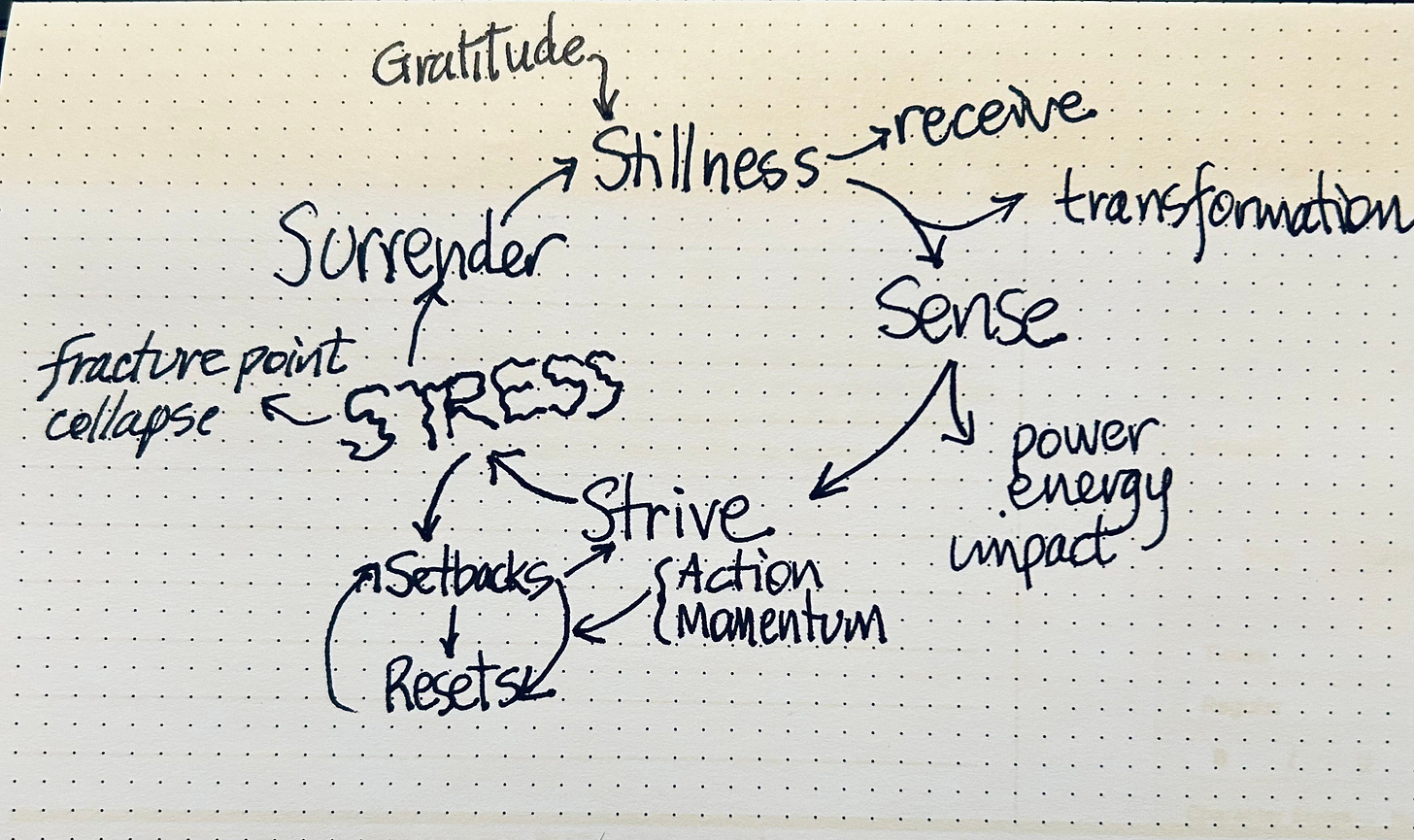Stillness, Stress & Surrender
In my experience of this life, I formulate and re-formulate numerous theories about how “life is”. I guess we all do. My theories began, simply enough, based on my senses and observations about the world, however incomplete. For example, I grew up in New York City and open space or wide fields of grass were inconceivable. I once was asked where I thought milk came from. I replied “King Kullen”, the name of the local grocery store a few blocks away. I knew what a cow was despite never having seen one. I wasn’t stupid; I simply never put the seemingly disparate concepts together.
In another example, I believed all policemen were good guys. So did my mother. After my brother and I found a paper bag packed full of money in the bushes, we debated what to do with it. We decided Mom would know. We showed it to her and she said “Get in the car.” We drove to the police station and my mother and my brother and I went to the tall counter where a uniformed officer sat. I couldn’t reach the counter. My mother explained that her two sons here found This, presenting the bag, and suggested that “someone may have lost it”. I watched the policeman’s eyes widen when he slowly opened the bag peering in and saw its contents. He instantly collected himself and said, “Thank you, ma’am, we’ll see to it.” My mother seemed satisfied that she did the right thing, but I wasn’t so sure. Walking out of the police station, I muttered to my brother, “He’s gonna keep it for himself.” My brother closed his eyes and nodded silently.
We make broad or sweeping assumptions based on small pieces of observable data. This of course is called inductive reasoning. It is the basis of what we call science. It’s not, and therein lies a big problem. Inductive reasoning says conclusions can be predicted from observable - and sometime erroneous - data.
Scenario:
You’re a cat secretly studying humans.
Observations:
Every time you walk across their keyboard, they give you attention.
When you knock objects off the table, they make loud noises and look at you.
When you sit directly on their book, they stop reading and focus on you instead.
Conclusion (Inductive Reasoning):
Humans are trained to obey cats. The more you disrupt them, the more attention they give. You must be their supreme ruler.
Wild, yet totally reasonable—if you’re a cat. 😼
Deductive reasoning is the opposite. I begins with a general rule or principle and applies it to a specific case to reach a logically certain conclusion. It moves from the general to the specific. This also has its drawbacks. For example:
All birds have feathers
A penguin is a bird
A penguin has feathers
This can go sideways quickly if the major premise is incorrect or flawed. For example:
Drugs make us healthy.
The more drugs we take the healthier we get.
I have gone through life making deductive conclusions and inductive conclusions. Because of my observations with my own father, I concluded that all fathers were violent and abusive under a nice or amiable facade. This seriously damaged my relationships with men and masculine authority figures until I reached high school. I added more data and re-assessed my theory.
Of course the first of 33 Principles of Chiropractic Philosophy, known as The Major Premise, states that “A Universal Intelligence is in all matter and continually gives to it all its properties and actions, thus maintaining it in existence.”
This principle suggests that there is an inherent, organizing intelligence in the universe that governs all things, including the human body. Chiropractors extend this idea to Innate Intelligence, the body's natural ability to self-heal and self-regulate, primarily through the nervous system.
From this premise, the logic of chiropractic care follows:
The body has an innate ability to heal itself.
The nervous system is the main communication pathway for this intelligence.
Spinal misalignments (subluxations) disrupt this process.
Chiropractic adjustments restore balance, allowing the body to function optimally.
I bet my life energy on this one.
But let’s move on to another concept I’m presently working with.
I recently attended a gathering of health professionals and listened to a number of speakers. One particular presenter piqued my interest and we spoke afterwards. This is the spark that lead me to this article. (Thank you, Dr. Kelly!)
We are creative beings who yearn to conjure ideas, build, and manifest our thoughts and dreams. As we strive toward our visions, we invariably run into obstacles or challenges and we circumvent these challenges in a variety of ways, with a variety of energy expenditures, in order to manifest those visions.
Before the striving began, however, we had the sensation of this potential manifestation. We had a feeling of its accomplishment, the emotion of the good it would do, the sense of expressing our purpose. Sometimes the plan appears all at once, like a yellow brick road. Other times, only a tiny piece is revealed at a time. Either way, the sensation usually comes out of a moment of silence or stillness. This is why I meditate and contemplate - to get into this still space. “Be still and know.”
In the silence, visions are conjured. Then the sensation of movement followed by striving or action. Action requires power, sometimes physical, sometimes energetic. During the action portion of this cycle, we run into minor obstacles (post office and bank is closed on Sunday) and overcome them with better planning, coping skills and resourcefulness. As setbacks arrive, we continue to move forward with a sense of purpose, momentum and will. Then the load increases and it gets more and more difficult to cope and strive beyond our skillset. We employ others to help, or outsource pieces of our project, get advice and the like to circumvent the obstacles. At some point (if our goal was lofty enough) we reach a stress point where we are completely tapped out of personal resources and alliances. We attempt to double down on personal effort and sheer willpower, but we are then fighting an uphill battle. Then comes a breaking point; a point when we can no longer bear the burden of the stress, and the result is a collapse or breakdown. This point is what I call the “fracture point”. It is sometimes known as the cascade theory of stress.
In the field of human psychology, when a critical stress point is reached in relation to achievement, several psychological phenomena can occur, often leading to breakdowns, growth, or changes in behavior. These critical stress points are typically related to pressure to succeed, expectations, or perceived failure.
I believe we’ve all been there. It is a point when we cannot go on anymore and we reach a point of accepting failure, retreating to old behaviors or settling for less than our dreams or something else. That ‘something else’ is surrender. Now I am not using the word to mean giving up or quitting. It’s more than that. It is the complete detachment of emotion from the end goal of the project and the insertion of an attitude of gratitude. Surrender can be positive in certain contexts. In psychology and personal growth, surrendering doesn’t always mean giving up or being passive. Instead, it can mean letting go of rigid control or resistance, which allows for acceptance, peace, and growth. This is what I wrote about in my book, “Love Through the Darkness”.
After the moment in this cycle called surrender comes a moment of silence. This is the “space between” where we receive divine grace and profound transformation. Once the resistance is dropped, as we stop fighting against what we can’t change, we make space for growth and healing in ways we hadn't anticipated. Often time this presents as new ideas and renewed vigor to accomplish our original goal. And with this renewed resilience, we become transformed. We have leveled up and can accomplish more. We have more power and more access to new realms of help.
In almost every great movie, the Hero’s Journey emphasizes this critical juncture. When Luke Skywalker’s instrument panel gets destroyed, he has to use the Force to guide his missiles to destroy the Death Star. In the Wizard of Oz, after finally reaching the tower of the wizard’s palace in Emerald City, we find out he is an ordinary man. Hopes and dreams are crushed. But then he provides the insights that the things our heroes sought were inside them all the time. Our protagonist (hero) comes up against insurmountable odds then surrenders. All hope is lost. But then! Unexpected help arrives to enliven the hero to succeed. This is the way of the hero. You are that hero. Do you agree? What do you do when you “can’t take it anymore”? What helps you get closer to your vision? Have you ever abandoned a vision?
“Is a dream a lie if it don’t come true, or is it something worse?” Springsteen
As always, thank you for reading these posts.
Love, Dr. Danny





